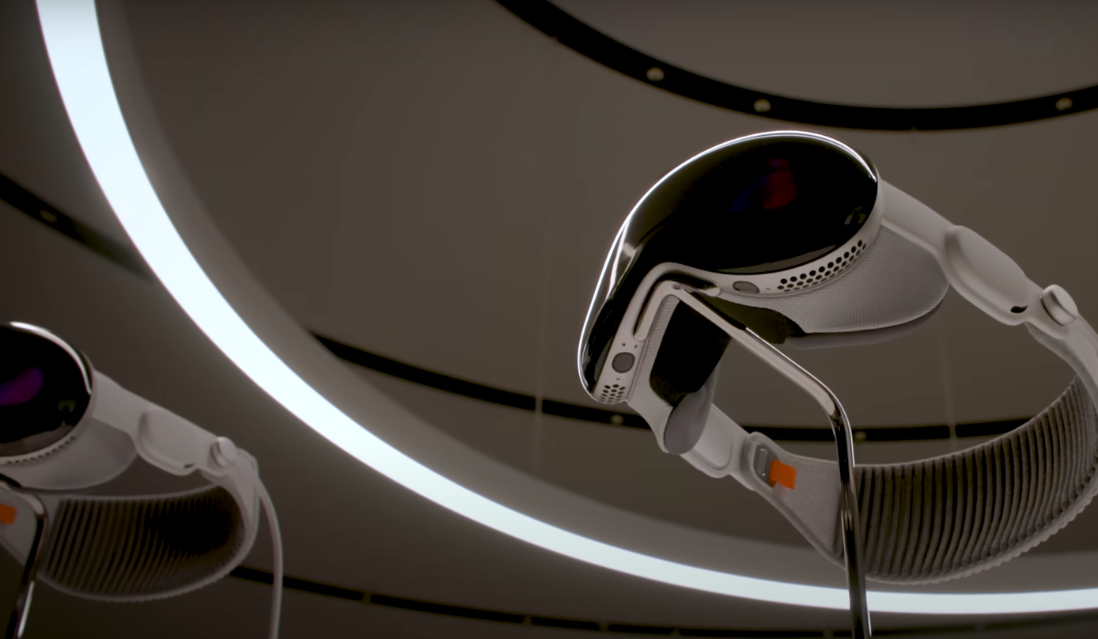Unveiling the Apple Vision Pro
Just when we thought that the technology is letting us mortals catch our breath, the masterminds at Apple have unveiled their latest marvel — Apple Vision Pro. The long-awaited augmented reality (AR) headset uses machine learning techniques to blend digital content with the physical space.
Apple’s ambitious project exemplifies how swiftly technology is transforming our lives, bringing us closer to a future where seamlessly integrating the physical and digital worlds becomes an everyday reality.
If you want to find out more about our eCommerce projects, we are here to help.
So, before we dive in and talk about the potential features, let’s start with what we know about the specs so far.
Specs
The AR set resembles a pair of ski goggles, with a continuous front glass which not only looks cool but also conceals a fan that cools the electronics inside. User experience is indeed taken to a whole new level and the experts at Apple seem to have thought about any possible shortfalls. For example, Zeiss worked in partnership with Apple to create magnetic lenses for prescription wearers.

The cool design is matched by complex software. visionOS, which Apple describes as “the first OS designed from the ground up for spatial computing” — powers the device and is the top choice for AR and virtual reality experiences. visionOS shares core blocks in common with MacOS and iOS but adds a “real-time subsystem” for processing interactive visuals on the Vision Pro.
The Vision Pro has an impressive set of hardware, too: two displays, one for each eye, with 23 million pixels across both. It’s like having 2 HD tvs, one for each eye delivering a far superior image.
The headset features two sets of cameras and lidar sensors. Inside, there are IR cameras that track the user’s eyes, while downward-facing cameras on the exterior of the headset track hands. The lidar sensors sense objects around the Vision Pro in real time, tracking their positions. In total, there are 12 cameras, five sensors and six mics.
In order to do all this real-time processing, Apple had to develop a brand-new processor – the R1, which together with the M2 chip, powers the headset. Apple claims that the R1 can process the sensor data within 12 milliseconds — eight times faster than the blink of an eye — and says this will dramatically reduce the motion sickness experienced in many other AR/VR systems.
Capabilities and Functions
Vision Pro is indeed a marvellous machine. Multitasking is possible and many apps can be accessed at the same time. Users can type using a virtual keyboard or simply use voice command. Vision Pro can also wirelessly connect to a Mac, providing users with a 4K display wherever they need it.
What sets this device apart from the competition is the fact that, having access to thousands of Iphone and Ipad apps, it can leverage the whole Apple ecosystem. This will give many people an innovative way of working on the go.
At the moment, the headset is focused on entertainment. Many say that it’s more of an AR device than a VR, although Apple praises its future VR capabilities. Once these will be developed, the full potential of this device will be tapped into.
Vision Pro and online retail
The Vision Pro could deliver various applications from professional fields such as architecture and engineering but at the moment, it is more focused on consumer-oriented applications like gaming or social interaction.

But what excites us more are features like real-time object recognition, gesture controls and spatial audio, for a truly immersive AR experience when the user shops online.
Apple Vision Pro has the potential to revolutionize shopping by bringing products to life in your own environment. Customers can view, examine, and interact with 3D models of products as if they were physically present. This can be particularly useful when shopping for products like furniture or clothing, where visualizing the product in a specific context (e.g., your living room or on yourself) can influence purchase decisions.
Additionally, their usage can help reduce return rates by providing a more accurate representation of products, helping customers make more informed purchasing decisions.
Thirdly, we all know that what online retail lacks is human interaction. AR can bridge the gap between online and physical retail by combining the convenience of online shopping with the interactivity of in-store experiences, potentially leading to increased customer satisfaction and loyalty. And Apple’s AR headset is praised for delivering one of the best close-to-reality experiences, and we are sure that the user experience when shopping using this device will be absolutely fascinating.
The only problem? Its hefty price tag…
How much does it cost
Although not available for a while (Apple announced an early 2024 sale date), the Vision Pro won’t come cheap. Priced at $3,499, it’s clear it won’t be accessible to the masses. But given Apple’s marketing tactics, there will surely be plenty of tech aficionados sleeping outside of the Apple stores before going on sale.
Conclusions
We’re always thrilled by technological progress, but the Apple Vision Pro gives us the impression that the futuristic scenes we observed in science fiction films during our childhood are now becoming a reality. This device truly stands out as a wonder in its field, and it’s impossible to ignore its potential for making our lives better. Currently, it appears that its primary purpose is to serve as an impressive entertainment device, providing users with a high-resolution display right in the comfort of their own living area. But we are eagerly waiting for the time when its use will extend way beyond that.
If you want to know more about our list of services at Clever++, please visit our website.




